The
Aircraft
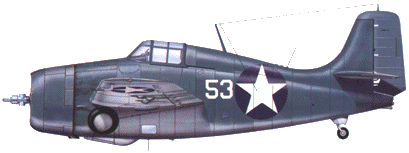
Grumman F4F Wildcat (Fighter)
This stubby but rugged plane was the main fighter for
the U.S. Navy and Marines during the hard-fought first year of the war. While not as fast
or as agile as its opponent the Japanese Zero, superior training and tactics of its pilots
allowed it to win many aerial combats. The Marine F4F-4 pictured above is in the markings
of a VMF-121 Wildcat frequently used by Captain Joe Foss. Click
HERE to see a 3-view picture of an F4F-4 as flown by another famous ace.
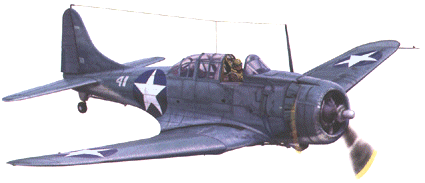
Douglas SBD Dauntless (Scout/Dive Bomber)
The Dauntless was the main carrier-based dive bomber
used by the U.S. Navy during the first two years of the war. It became famous for its
steep bombing dives that resulted in the sinking of four Japanese carriers at the Battle
of Midway. The U.S. Marines used their Dauntlesses from land bases, and at Guadalcanal
used them to sink numerous Japanese ships attempting to land troops on the island.
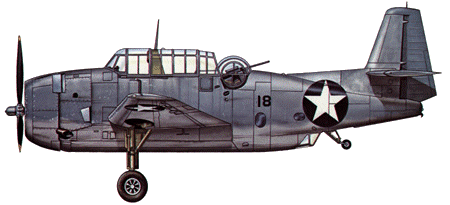
Grumman TBF Avenger (Torpedo Bomber)
Avenger torpedo bombers saw their first combat a mere
two months before the invasion of Guadalcanal (at the battle of Midway). Both the U.S.
Navy and Marines used the Avenger during the Guadalcanal campaign. Marine Avengers
from Henderson Field attacked the Japanese battleship Hiei (in the first torpedo
attack ever made by Marine aviators), scoring 2 hits. Navy Avengers from the Enterprise
finished off the Hiei, which was the first battleship to be sunk by the U.S.
Navy.
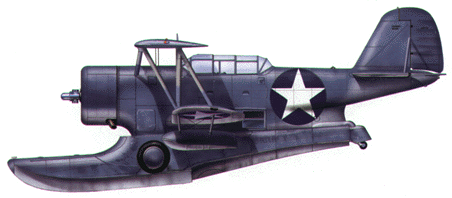
Grumman J2F-5 Duck (Utility/Observation Seaplane)
Marine and Navy crews flew a Grumman J2F Duck for rescue
missions around Guadalcanal. Joe Foss went on one such mission searching for Lieutenant
Colonel Bauer, who was spotted alive in the water after his aircraft had been shot down.
Unfortunately, by the time the Duck arrived at the scene, Bauer was nowhere to be found.
(Click HERE for the story of Colonel Bauer's last mission and
the attempt to rescue him.)
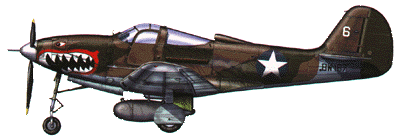
Bell P-39/P-400 Airacobra (Fighter)
Not all of the aircraft on the island were Marine or
Navy aircraft. The Army Air Forces' 67th Fighter Squadron arrived on Guadalcanal
shortly after the Marines, and they remained into 1943. The main fighter of the 67th
was the P-39 Airacobra, and its export variant the P-400 (the more common of the two types
on Guadalcanal). These were used as fighters and bombers by the 67th. They were not
successful as air fighters, but could be well used in the ground attack role. (See the Painting Gallery for a painting of the P-39 in action.)
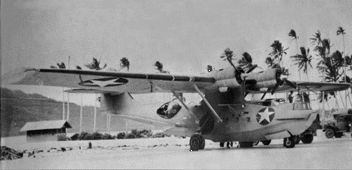
Consolidated PBY Catalina Flying Boat
The Catalina was used for long-range reconnaisance and
rescue work. Being slow, sluggish, and poorly armed, it was generally not considered a
combat aircraft. However, an event during the Guadalcanal campaign changed this somewhat.
The PBY-5A pictured above was the personal aircraft (nicknamed the "Blue Goose")
of General Geiger; it was used to ferry supplies to the Marines on the island. One day it
brought a pair of aerial torpedoes, one under each wing, back to the island to help
re-supply the Avengers stationed there. Unfortunately, the Avengers were all out-of-action
when the PBY arrived, and a Japanese fleet was approaching with enough troops to retake
the island. Realizing that their backs were against the wall, Major Jack Cram (General
Geiger's junior aide and personal pilot) had the Catalina rigged with manual releases for
the still-slung torpedoes, and took the lumbering amphibian in a suicidal attack on the
Japanese transports. Incredibly, he and his crew not only survived the attack, but he
scored a hit on a transport. Shot up and pursued by Zeros all the way back to Henderson
Field, he managed to safely land with 175 bullet holes in his plane. General Geiger
berated him for abuse of government property, but promptly wrote out a recommendation for
the Navy Cross for his aide. (See Page 2 of "The Men" section
for a picture of Major Cram and to read about this incident in Cram's own words.)
(aircraft drawings on this page
are from Squadron/Signal publications'
"Marine Fighting Squadron One-Twenty-One (VMF-121)" by Thomas Doll
and "Navy Air Colors (Vol. 1, 1911-1945)" by Thomas Doll)
Click HERE if navigation menu is not visible on the left





